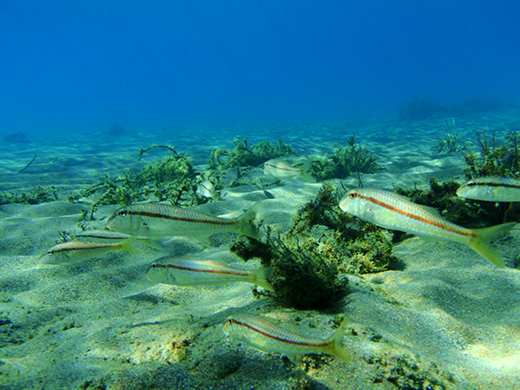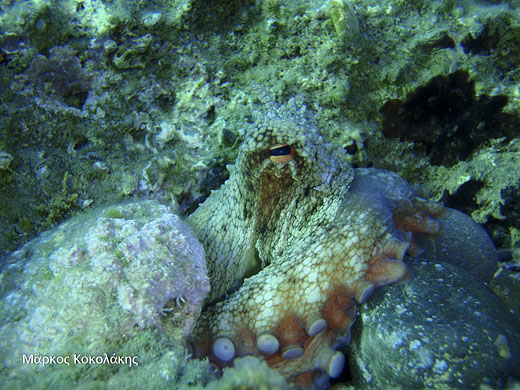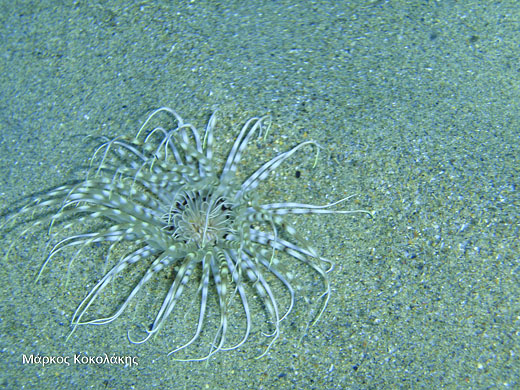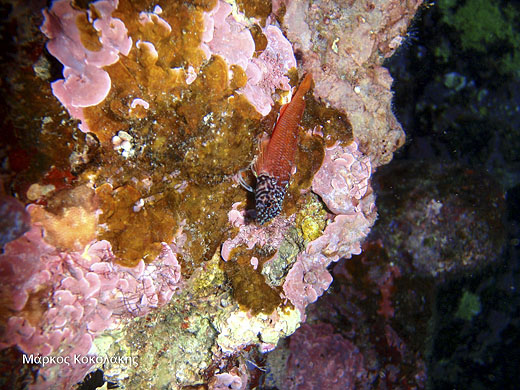The natural wealth of Crete is not limited to its mountains, gorges, rare biotopes and beaches. It goes deeper than that, literally!
 The seabed of the island hides another magical world, where colors explode, fish become camouflage masters, corals (yes, there are corals in Crete!) create astonishing shapes, octopuses and moray eels indolently lurk from their hideouts, and damselfish wander around in herds! The inhabitants of the Cretan seabed include other strange looking creatures: molluscs, sea anemones, oysters, small and big fish, neptune grass valleys, endemic species, tropical 'immigrants' who come to the Mediterranean through the Suez canal and more.
The seabed of the island hides another magical world, where colors explode, fish become camouflage masters, corals (yes, there are corals in Crete!) create astonishing shapes, octopuses and moray eels indolently lurk from their hideouts, and damselfish wander around in herds! The inhabitants of the Cretan seabed include other strange looking creatures: molluscs, sea anemones, oysters, small and big fish, neptune grass valleys, endemic species, tropical 'immigrants' who come to the Mediterranean through the Suez canal and more.
This underwater society remains largely unknown, as diving tourism has not been promoted in Crete, and seabed fans seek their next adventure in the brochures of other exotic destinations.

Markos Kokolakis, an amateur diver, fisherman and sea lover, offered to us his collection of underwater photographs, shot at the coastline between the beaches of Tsoutsouras and Koudouma Monastery. In other words, at the seabed of our favorite beaches in Asterousia region, under the shadow of the southernmost mountain chain of Europe.
With this photoreportage we want to say to sea lovers that they don't need to travel far to enjoy a rewarding underwater adventure: this colorful treasure is located only 3 meters deep into the sea. And if you prefer staying on the land, we will take you there through these wonderful images!
Take a deep breath and enjoy!

Under the crystal clear waters of Asterousia beaches!

A sea anemone (Pachycerianthus solitaries), permanent resident of the sand.

From this under-the-rock view we see a colorful canvas made of sea sponges and bryozoans.

An army of mullets in search of dinner.

A common sole tricks us with camouflage and becomes invisible to the inexperienced divers.

Did you know that the octopus is one of the smartest mollusks? It is evident, from its scintillating look!

A small grouper, hidden under a rock.

"We are the titillating blue damselfish!"

A scorpionfish masters her camouflage techniques.

The false coral Μyriapora truncata

A colorful rainbow wrasse.

This elaborate lace is just....mollusk eggs!

We loved this one, because of its name: Moonshell (Neverita Josephina)!

Find the fangtooth moray, hidden in the colorful reefs! It belongs to the Enchelycore anatina species, a recent entry in the Mediterranean sea.

The purple sea urchin (Sphaerechinus granularis) loves the shadows.

A colony of yellow-orange sponge (could it be Bob;)

Sargo and oblade fish go together!

The purple urchin again...

A fangtooth moray (Enchelycore anatina) protects its space (in other words, back off!)

(but, it has photogeny!)

It looks like a sea lettuce, but actually it is a cluster of calcified algae!

An underwater window overlooking the deep blue.

Meet the bearded fireworm (Ηermodice carunculata). It eats dead animals and if you touch it you will win...unforgettable moments of itchiness and pain!

A wall covered by blue sponges and small corals (!)

Calcified algae shape rose petals (or whatever else your imagination wants!)

Another hidden fangtooth eel (Enchelycore anatina).

Brown and orange sponges live side by side.

An octopus sneaks out of its hideout to spy on the uninvited visitor. You!

A little scorpionfish plays hide and seek.

Lunch break! The scorpionfish devours a threefin (Tripterygion sp.)

Α Tentacled blenny is supervising its space (what do you mean you can't see it?)

A herd of damselfish (Chromis chromis)

A sea snail lays its eggs in a rock chasm.

Let us introduce to you the one and only rengeroworm!

Staring contest with an octopus.

The scorpionfish raises her poisonous spikes!

Brown algae love the sunny zones of the sea.

Red algae and hydrozoa, one the other hand, prefer the shade.

Sponges that live in shadowy spaces acquire a grey– white color (yes, that grey thing is a sponge!)

A giant triton (Charonia tritonis), one of the largest marine gastropod mollusc in the Mediterranean, is threatened by men because of its habit to adorn its home with shells :-(

A red starfish (Echinaster sepositus)!

The pearly razorfish (Xyrichus novacula) resides in the sand!

A sea anemone (Pachycerianthus solitaries)

And another one! This one belongs to the Cerianthus membranaceus species.

It's not a flower, it's a worm!

A rengeroworm close-up!

A dancing octopus!

The exotic bluespotted cornetfish Fistularia comersonii (Find it in the seaweed!)

An octopus blocks the entrance of his house with stones and sea shells!

The fireworm again!

Admire it but do not touch it...

"I will just sit here and be quiet"...

A sea phantasmagory.

The exotic crab Percnon gibessi.

The thorny oyster (Spondylus gaederopus) is an edible marine bivalve mollusc.

A sea snail (Serpulorbis arenarius) eternally builds its home. Killing time in the seabed....

A red sea squirt (Halocynthia papilosa).

A born protagonist.

(Do fish have antennas?)

Find the sea creature...

Things got a bit cramped...

A coco worm spreads its impressive fan.

My name is Tina, from 'Enchelycore Anatina'.

Pachygrapsus marmoratus is the common crab of the rocky shores.

Hey friend, do you want to see my collection of sharp teeth?

Rockpool Shrimp (Palaemon elegans).

A feast of colors in an underwater, living collage.

The seabed stimulates the imagination.

An underwater landscape in constant flux...

And it changes...

And it is filled with colors!

Eccentric fish.

A pure black sponge!

The color orange is again in fashion, in the catwalks 3m. below the surface!








